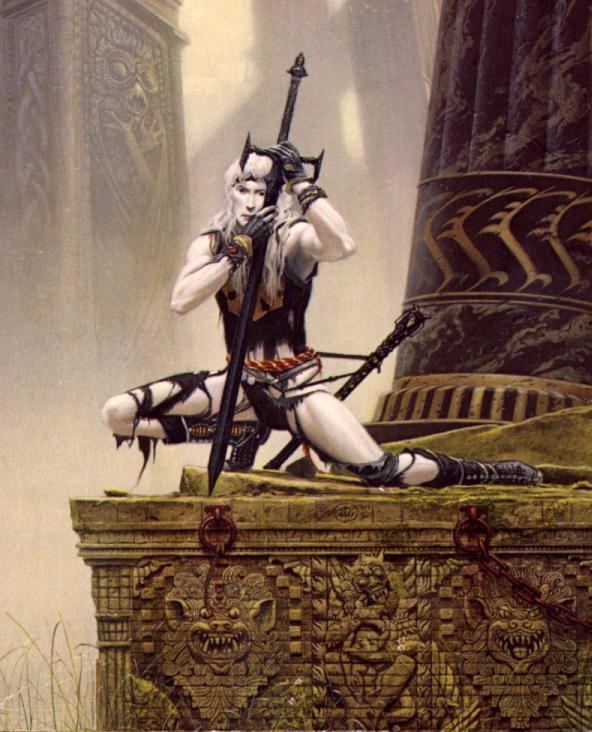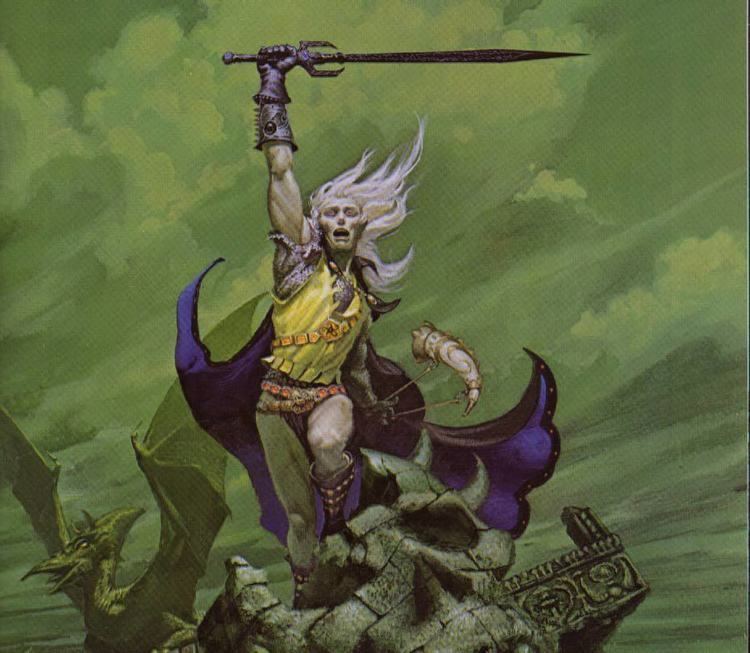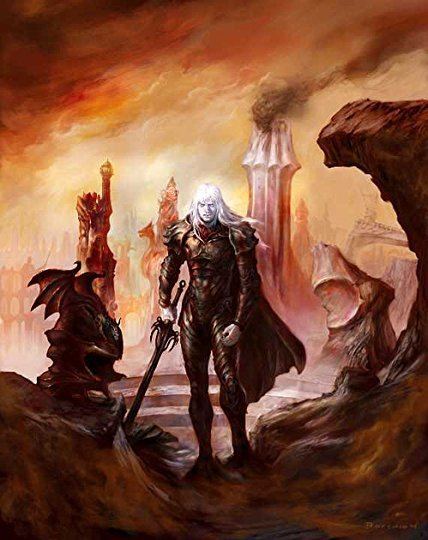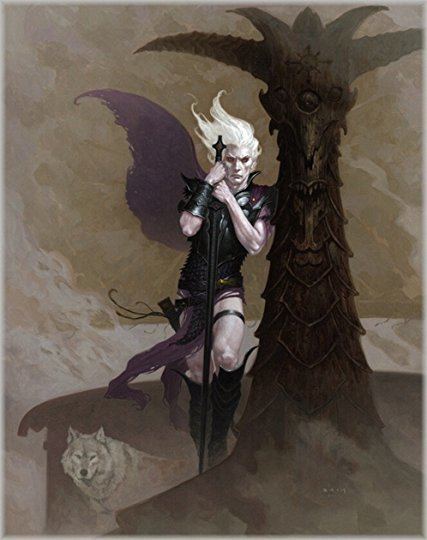Gender Male Nationality Melnibonean | ||
 | ||
Title Elric VIII, 428th Emperor of Melniboné Similar Corum Jhaelen Irsei, Dorian Hawkmoon, Conan the Barbarian, Jerry Cornelius, Deities in the Elric series | ||
Elric vol 1 the ruby throne
Elric of Melniboné is a fictional character created by Michael Moorcock and the protagonist of a series of sword and sorcery stories taking place on an alternate Earth. The proper name and title of the character is Elric VIII, 428th Emperor of Melniboné. Later stories by Moorcock marked Elric as a facet of the Eternal Champion.
Contents
- Elric vol 1 the ruby throne
- Fictional history
- Influences
- Publishing history
- Internal Chronology
- Collections
- Characters in the Elric series
- Comics
- Music
- Film
- Role playing games
- References

Elric first appeared in print in Moorcock's novella "The Dreaming City" (Science Fantasy No. 47, June 1961). Moorcock's doomed albino antihero is one of the better known in fantasy literature, having crossed over into a wide variety of media, such as role-playing games, comics, music, and film. The stories have been continuously in print since the 1970s.

Fictional history
Elric is described in 1972's Elric of Melniboné:

It is the colour of a bleached skull, his flesh; and the long hair which flows below his shoulders is milk-white. From the tapering, beautiful head stare two slanting eyes, crimson and moody, and from the loose sleeves of his yellow gown emerge two slender hands, also the colour of bone.

Elric is the last emperor of the stagnating island civilisation of Melniboné. Physically weak and frail, the albino Elric must take drugs (special herbs) to maintain his health. Unlike most others of his race, Elric has a conscience; he sees the decadence of his culture, which once ruled the known world, and worries about the rise of the Young Kingdoms, populated by humans (as Melnibonéans do not consider themselves such) and the threat they pose to his empire. Because of his introspective self-loathing of Melnibonéan traditions, his subjects find him odd and unfathomable, and his cousin Yyrkoon (next in the line of succession, as Elric has no heirs) interprets his behaviour as weakness and plots Elric's death.

In addition to his skill with herbs, Elric is an accomplished sorcerer and summoner. As emperor of Melniboné, Elric is able to call for aid upon the traditional patron of the Melniboné emperors, Arioch, a Lord of Chaos and Duke of Hell. From the first story, Elric uses ancient pacts and agreements with not only Arioch but various other beings—some gods, some demons—to help him accomplish his tasks.

Elric's finding of the sword Stormbringer serves as both his greatest asset and greatest disadvantage. The sword confers upon Elric strength, health, and fighting prowess, allowing him to do away with his dependence on drugs, but it must be fed by the souls of intelligent beings. In the end, the blade takes everyone close to Elric and eventually Elric's own soul as well. Most of Moorcock's stories about Elric feature this relationship with Stormbringer, and how it—despite Elric's best intentions—brings doom to everything he holds dear.
Influences

Moorcock acknowledges the work of Bertolt Brecht, particularly Threepenny Novel and The Threepenny Opera, as "one of the chief influences" on the initial Elric sequence; he dedicated 1972's Elric of Melniboné to Brecht. In the same dedication, he cited Poul Anderson's Three Hearts and Three Lions and Fletcher Pratt's The Well of the Unicorn as similarly influential texts. Moorcock has referred to Elric as a type of the "doomed hero", one of the oldest character-types in literature, akin to such hero-villains as Mervyn Peake's Steerpike in the Titus Groan trilogy, Poul Anderson's Scafloc in The Broken Sword, T. H. White's Lancelot in The Once and Future King, and Jane Gaskell's Zerd in The Serpent.
The story of Kullervo from Finnish mythology contains elements similar to Elric's story, such as a talking magic sword and fatal alienation of the hero from his family. Besides Elric, Kullervo has been proposed as having influence on Poul Anderson's 1954 novel The Broken Sword, and J.R.R. Tolkien's Túrin Turambar. Moorcock has stated that "Anderson's a definite influence [on Elric], as stated. But oddly, the Kalevala was read to us at my boarding school when I was about seven", and "from a very early age I was reading Norse legends and any books I could find about Norse stories". Moorcock in the same posting stated "one thing I'm pretty sure of, I was not in any way directly influenced by Prof. T[olkien]".
Elric's albinism appears influenced by Monsieur Zenith, an albino Sexton Blake villain whom Moorcock appreciated enough to write into later multiverse stories. Moorcock read Zenith stories in his youth and has contributed to their later reprinting, remarking that it "took me forty years to find another copy of Zenith the Albino! In fact it was a friend who found it under lock and key and got a copy of it to Savoy who are, at last, about to reprint it! Why I have spent so much energy making public the evidence of my vast theft from Anthony Skene, I'm not entirely sure... ". Moorcock later said, "As I've said in my introduction to Monsieur Zenith: The Albino, the Anthony Skenes character was a huge influence. For the rest of the character, his ambiguities in particular, I based him on myself at the age I was when I created Elric, which was 20". The influence of Zenith on Elric is often cited in discussions of Zenith.
Publishing history
Elric first appeared in print in a series of five novelettes, published in Science Fantasy magazine:
After this came four novellas:
The last of these terminated the sequence with the close of Elric's life. After these initial Elric tales, Moorcock periodically published short tales throughout the 1960s and early 1970s, such as 1967's "The Singing Citadel" and 1973's "The Jade Man's Eyes". Meant to be placed in between the initial stories but before the conclusion of "Doomed Lord's Passing", these later stories would frequently be edited, retitled, and combined together with other material to form fix-ups as part of later republication campaigns.
The first original Elric novel, 1972's Elric of Melniboné, was a prequel detailing Elric's origin and how he came to possess Stormbringer. In 1989 came the second original Elric novel, The Fortress of the Pearl, followed in 1991 with The Revenge of the Rose. A decade later Moorcock began an original Elric trilogy, beginning with The Dreamthief's Daughter (2001), followed by The Skrayling Tree (2003) and The White Wolf's Son (2005).
Internal Chronology
The main sequence, according to the saga's internal chronology, comprises the following books (in those cases where a book is composed of several titled sub-stories, these are listed):
Collections
The first five novelettes were originally collected in The Stealer of Souls (1963) and the later four novellas were first published as a novel in an edited version called Stormbringer (1965). The 1965 novel had about a quarter of the text removed for reasons of length (mostly in the second and third novellas) and the remaining text rearranged with new bridging material added to make sense of the restructuring.
In 1977, DAW Books republished Elric's saga in six books that collected the tales according to their internal chronology. These paperbacks all featured cover art work by the same young artist, Michael Whelan, and helped to define the look of both Elric and his sword Stormbringer. The DAW edition of Stormbringer restored some of the original structure and text compared to the 1965 release, but other revisions were performed and other material excised. A few oddments were collected in Elric at the End of Time (1984), which became the seventh book in the DAW line when DAW released it in the US in 1985. It includes two Elric-related tales: the title story and 1962's "The Last Enchantment", originally intended as the final Elric story but put aside in favour of those that eventually made up Stormbringer; it was not published until 1978. Both would appear in later collections (with "The Last Enchantment" occasionally retitled "Jesting with Chaos").
In the 1990s, Orion Publishing/Millennium released a two-book collection – Elric of Melniboné and Stormbringer – containing the Elric material then available. White Wolf Publishing released a similar two-volume compilation – Elric: Song of the Black Sword (1998) and Elric: The Stealer of Souls (2001). The White Wolf text has minor revisions when compared to the Millennium release.
The early version of the Elric saga, i.e., the first nine short stories – with "The Flame Bringers" using the later title of "The Caravan of Forgotten Dreams" and the full text of Stormbringer as it appeared in Science Fantasy – was republished in a single volume as Elric (Orion/Gollancz 2001), volume 17 in the Fantasy Masterworks series.
Beginning in 2008, Del Rey Books reprinted the Elric material as a series of illustrated books: The Stealer of Souls, To Rescue Tanelorn, The Sleeping Sorceress, and Duke Elric (in 2009). 2009's Elric in the Dream Realms reprinted Fortress of the Pearl, and 2010's Swords and Roses reprinted other later material. The version of Stormbringer featured in the 2008 Del Rey collection restored all the original material missing since the 1977 DAW edition – which had formed the basis for all later editions – as well as Moorcock's preferred versions of all the revised material in an attempt to produce a definitive text. These volumes present the evolution of the character through early fanzine stories, early musings by Moorcock, some Elric stories, some others introducing the reader to the wider "Eternal Champion" theme, stories of other heroes who coexist with Elric in the realm of Melniboné, unpublished prologues, installments of Moorcock's essay "Aspects of Fantasy", a 1970s screenplay, a reader's guide, and notes from an Elric series that never developed.
In August 2012, Victor Gollancz Ltd. announced their intention to republish all of Michael Moorcock's back catalogue, including all the Elric stories, presented in internal chronological order along with previously unpublished material, and in both print and e-book formats. The Elric volumes were released in 2013 and 2014.
Characters in the Elric series
Cymoril: A Melnibonéan, Elric's cousin and consort. He hopes to one day make her his wife and empress. She tries to understand and help Elric, but like his subjects, she has difficulty understanding Elric's motivations and would have him rule as the emperors of old, with no concern for any but himself.
Dyvim Slorm: A Melnibonéan, Elric's cousin, son of Dyvim Tvar. He fights alongside Elric in the final war against Chaos, wielding the black sword Mournblade.
Dyvim Tvar: A Melnibonéan, one of Elric's few friends. He is one of the Dragon Masters, a group of Melnibonéans who can speak to the Dragons of Melniboné. Dyvim Tvar stays loyal to Elric even after he destroys Imrryr. Dyvim Tvar also has more of a moral compass than most Melnibonéans.
Ernest Wheldrake: An amiable poet and bard who involuntarily travels across the Multiverse. Amorous and good-natured, he is given to sudden expulsions of verse and song. He is writing an epic poem about Elric during their shared adventures.
Jagreen Lern: The cruel ruler of Pan Tang, skilled with both magic and the use of a battleaxe.
Moonglum of Elwher: A short, red-haired human with a cheerfully ugly face, adventuring companion to Elric. He and Elric share many dangers and rewards together. The most steadfast and loyal companion of all the Young Kingdom humans Elric encounters. He helps Elric in completing his fated purpose.
Myshella of Law: Colloquially referred to as the Empress of the Dawn and The Dark Lady of Kaneloon, the powerful sorceress Myshella has acted as a guide and consort to Eternal Champions and adventurers alike down through the ages in the ineffable pursuit of Law. Immortal, ageless, and indescribably powerful. She sometimes rides a metal bird with emerald eyes, and more than once lends this mount to Elric.
Oone: A Dreamthief by trade, at the Silver Flower Oasis in the Sighing Desert, Lady Oone helps Elric locate The Fortress of the Pearl when another of her order dies in a previous attempt. Her fleeting romance with the albino has considerable significance during the later 'Moonbeam Roads' trilogy.
Prince Gaynor The Damned: A fallen knight of the Balance, doomed to suffer without release by the forces of Chaos. He inhabits a formless existence, imprisoned in a black-and-gold suit of armor emblazoned with the 8-pointed symbol of Chaos.
Rackhir, the Red Archer: A human, once a Warrior Priest of Phum but cast out of his order. He and Elric travel and adventure together several times throughout the series. unlike other characters who serve either Law or Chaos, Rackhir devotes himself to the Balance exclusively.
Sepiriz: One of the ten remaining Nihrain, this dark-skinned servant of the Balance guides Elric through the final phases of his quest. He is also sometimes called 'The Knight in Black and Yellow'.
Shaarilla of Myyrrhn: The daughter of a dead necromancer, Shaarilla of the Dancing Mist was born a mutant and an outcast among her people. Unlike her fellows of Myyrrhn, Shaarilla was born without wings. She enlists Elric to locate The Dead Gods' Book in the hopes it might contain a spell to reverse her deformity.
Smiorgan Baldhead: A Count of the Isle of the Purple Towns, and an affable adventurer who accompanies Elric on his adventures on the Nameless Continent. His fleets aid in the Sacking of Imrryr.
Theleb K'aarna: A human sorcerer of the Pan Tang isles. After being displaced as Queen Yishana's advisor and chief sorcerer by Elric, he seeks revenge and uses sorcery to hinder several of Elric's plans.
The Rose: A beautiful, scarlet-haired warrior Elric encounters on his journeys through the Multiverse. She wields a Lawful counterpart to Elric's Chaos-forged demonblade 'Stormbringer' named 'Swift Thorn'. Serving neither Law nor Chaos, she has sworn an oath of revenge against Gaynor The Damned for the eradication of a universe that was precious to her.
Yishana of Jharkor: A human, ruler of Jharkor. She presents Elric with several problems/adventures and openly covets his company and power. Her selfish desires are the root of several of Elric's problems, but she also aids him from time to time and ultimately becomes an important ally in his fight against Chaos.
Yyrkoon: Prince of Melniboné, Elric's cousin. He is next in line for the throne, as Elric has no male heir. He worries about Elric's behaviour and takes all of Elric's brooding and philosophical talk as a sign of weakness. He yearns for a return to more traditional emperors and secretly plots Elric's demise. Yyrkoon is a great sorcerer who has made many pacts with unholy forces to obtain his sorcerous strength. As further evidence of his decadent ways, he openly desires his sister Cymoril and intends to make her his wife and Empress if his plans ever reach fruition.
Zarozinia: A human of the Young Kingdoms. She falls in love with Elric and eventually marries him, for a time allowing him to experience true love and companionship. For her sake, Elric also gives up his blade Stormbringer and reverts to taking sorcerous herbs to sustain his life.
Comics
Elric first appeared in comics in 1972, in Conan the Barbarian issues 14–15, an adventure in two parts entitled "A Sword Called Stormbringer!" and “The Green Empress of Melniboné”. The comic was written by Roy Thomas and illustrated by Barry Windsor-Smith, based on a story plotted by Michael Moorcock and James Cawthorn.
Star Reach comics published Elric stories in the late 1970s. First Comics published several Elric mini-series in the 1980s as well.
Elric also appeared in a number of original stories published by DC Comics. Helix, a short-lived science-fiction and fantasy imprint of DC, published the 12-issue Michael Moorcock's Multiverse from 1997. In 2004, DC Comics published the four-issue Elric: Making of a Sorcerer, with art by Walt Simonson, a story about Elric's magical training before the events of the novel Elric of Melniboné.
P. Craig Russell has drawn comics adaptations of three Moorcock novels: Elric of Melniboné (with Roy Thomas and Michael T. Gilbert; Pacific Comics), The Dreaming City and While the Gods Laugh (representing the first two-thirds of Weird of the White Wolf; Marvel/Epic Comics), and Stormbringer (Dark Horse). The character has also been adapted by Walter Simonson and Frank Brunner, and by George Freeman and others on the long-running Elric series at Pacific which Russell had co-created. (Reportedly tensions between him and Thomas were the reason for his departure.)
Adam Warlock, under artist Jim Starlin, was influenced by Elric and made into a Marvel Comic version of that superhero, with concepts such as the Soul Gem stealing souls, the introduction of Master Order and Lord Chaos. The premise is similar to the Adam Warlock soul-stealing gems, which may well have borrowed from Elric.
Tom Strong No. 31 and No. 32, The Black Blade of the Barbary Coast part 1 & 2, written by Moorcock, feature albino pirate Captain Zodiac seeking the "Black Blade", a black cutlass marked with red runes. This presents a recurrence of Elric and Stormbringer, with a liberal dash of Monsieur Zenith.
2011 marked the launch of another Elric-based comic, Elric: The Balance Lost by BOOM! Studios. The series, written by Chris Roberson and drawn by Francesco Biagini, is available in both traditional hard copy and for digital download.
In 2014, The Ruby Throne, the first volume of a new four-volume adaptation of Elric of Melniboné written by Julien Blondel and illustrated by Didier Poli, Jean Bastide, and Robin Recht, was published by Titan Comics. Stormbringer, the second volume was published in March 2015 by the same team and publisher. Moorcock states that this is his favorite comic adaptation of his Elric stories to date and praises the subtle changes to the original story, saying that he wishes he had made them himself. The third volume, entitled 'The White Wolf', will be released in September of 2017.
Music
The Chronicle of the Black Sword is a 1985 album by UK space rock band Hawkwind. Moorcock and Hawkwind had, at this stage, collaborated a number of times. An expanded live album, Live Chronicles, was released in 1986. This included several spoken-word interludes by author Moorcock in his capacity as on-stage narrator. The live show also included a mime artist portraying Elric himself. A video concert film entitled The Chronicle of the Black Sword appeared on VHS and later on DVD.
The song "Black Blade" was recorded for the album Cultösaurus Erectus (1980) by Blue Öyster Cult, written by singer/guitarist Eric Bloom with lyrics by Moorcock. Moorcock also collaborated on the songs "The Great Sun Jester" (Mirrors (1979)) and "Veteran of the Psychic Wars" (Fire of Unknown Origin (1981)).
The heavy metal band Tygers of Pan Tang take their name from the fictional islands of Pan Tang in the Elric series, where the ruling wizards keep pet tigers.
In 1974, the UK hard rock band Deep Purple released an album entitled Stormbringer. In a 1974 interview with New Musical Express, David Coverdale said he "never even considered Michael Moorcock's work" writing the song.
Influential new wave of British heavy metal band Diamond Head made Elric one of the primary lyrical subjects of their seminal 1982 release Borrowed Time and featured the character on the cover art. Songs from this release would gain further visibility when they were re-recorded by Metallica.
Washington State Thrash/Black metal band NME released the song "Stormbringer" on their 1986 album Unholy Death.
The German band Blind Guardian has written several songs pertaining to Elric's story and Stormbringer, including "The Quest For Tanelorn", "Tanelorn (Into The Void)", and "Fast To Madness".
The Italian power metal band Domine has based most of their albums on the Elric saga.
The second studio album Agents of Power by American heavy metal band SKELATOR contains "Elric: The Dragon Prince (A Tale Of Tragic Destiny In 12 Parts)", a 40-minute Elric epic.
The Serbian fantasy metal band Númenor has written several songs on their debut album Colossal Darkness based on Elric of Melniboné stories including: The Eternal Champion, The Sailor on the Seas of Fate and While the Gods Laugh.
Swedish melodic black/death band Sacramentum (band) have referenced characters and themes such as the cult of Slortar on their 1999 album Thy Black Destiny, notably the track "Overlord".
The Greek epic metal band Battleroar has written the song "Mourning Sword" on their debut album Battleroar.
Swedish heavy metal band Grand Magus released "Steel Versus Steel", about Elric's dependence on Stormbringer's corrupting power, on their 2014 album "Triumph and Power".
Film
Wendy Pini published a book documenting her attempt to make an animated film project of the Stormbringer series. Law and Chaos: The "Stormbringer" Animated Film Project (ISBN 0936861045) was published by Father Tree Press of Poughkeepsie, New York in 1987. The book contains original artwork, information on the characters, an overview of the plot, and her personal investment in the project. The film, however, never reached completion.
On 29 May 2007, in an interview with Empire Magazine, directors Chris and Paul Weitz revealed that they are in the process of adapting a trilogy of films based on Elric for Universal Pictures. Chris grew up reading the material and has met with Moorcock, who trusted them with the project.
Role-playing games
Elric (along with Stormbringer) was listed in the first printing of Advanced Dungeons & Dragons (AD&D) Deities & Demigods rule book. However, Chaosium already had a role playing series in the works based on Elric & Stormbringer and the initial AD&D printing was not fully authorised. A mutually beneficial deal was worked out between Chaosium and TSR, yet TSR chose to remove Elric from later printings of Deities & Demigods.
The world of Elric's Young Kingdoms was the setting of the Stormbringer role-playing game by the publisher Chaosium (Hawkmoon has also been so treated, as has Corum). After a disagreement between Moorcock and Chaosium, the Stormbringer line was discontinued. In 1993 Chaosium released Elric! which still used their BRP system. Its main difference was in the way magic through demon summoning was detailed and the allegiance system that saw characters lean either towards law, chaos or the balance, themes that underscored the books. Subsequently, a new version called "Elric of Melnibone" was published by Mongoose Publishing under their Runequest system.
